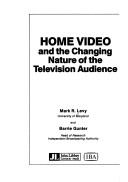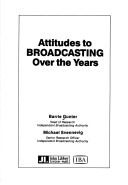I.B.A.Television Research Monograph
6 total works
From the earliest days of television there has been concern about the portrayal of violence in programmes. This anxiety has led to calls for stricter controls over what is shown on the screen. The problem of what to control however is a practical one. What should be cut out or left in programmes? It is far from easy to produce a system of guidelines and controls which take full account of the values and tastes of the people who matter, namely the audience. In the long-running debate about TV violence, all too often the opinions of the viewers themselves are forgotten, ignored or oversimplified. This research monograph examines in detail what the viewers think about violence on television and reports on general opinions about TV violence as well as perceptions in eg drama and news programmes, and in named series. The surveys reveal that public opinion about TV violence is varied and much depends on how questions about the issue are put. Certain segments of the audience are concerned about TV violence but on balance British viewers do not express extremes of concern.
Overall, public opinion seemed to indicate support for a system of regulation which is sensitive to existing values and tastes rather than of strict censorship, one which operates within a climate of shared responsibility among both broadcasters and viewers with regard to what is televised and what is defined as acceptable.
Overall, public opinion seemed to indicate support for a system of regulation which is sensitive to existing values and tastes rather than of strict censorship, one which operates within a climate of shared responsibility among both broadcasters and viewers with regard to what is televised and what is defined as acceptable.
Home Video and the Changing Nature of the Television Audience
by Mark R. Levy and Barrie Gunter
Published March 1988
Attitudes to Broadcasting Over the Years
by Barrie Gunter and Michael Svennevig
Published February 1988
Every year since 1970 (with the exception of 1978) the IBA has undertaken a large national survey to assess public attitudes towards broadcasting in Britain. The survey asks a "core" series of identical questions on viewers' and listeners' opinions about all commercial broadcasting and then, for comparative purposes, many of the questions are asked about equivalent BBC services. Also asked are questions about people's access to the wide range of technologies now available. As this monograph reveals, most viewers and listeners have been satisfied with programme standards with repeats being the main source of complaint. A consistent finding over the years has been that only a small minority of the audience is offended by bad language, sex or violence and viewers are becoming increasingly aware of the family viewing policy and agrees with the watershed time of 9.00pm for programmes considered unsuitable for children. Finally, the public are cautiously optmistic about the possibility of having access to a far greater number of television and radio services. Enthusiasm for the new is, however, tempered by considerations of cost and quality.
The observation of male and female models in the child's environment has been postulated as a major source of sex-role information, while the audio-visual mass media is one of the two principle sources of models for the developing child. Research which has examined the way the sexes are portrayed on television has noted a pronounced stereotyping of women in adult daytime, peak-time and children's programming and in advertisements, which has led writers interested in the elimination of sex stereotypes to request an enforced balance in the portrayal of social and occupational roles which have traditionally been presented as exclusively or predominantly associated with one or other sex. According to the conclusions of this work, stereotyping has been characterized by two principal features: firstly, there is a gross under-representation of women in action-drama programmes in terms of actual numbers relative to the presence of men, something which has been referred to by one writer as the "symbolic annihilation of women". Secondly, even when women do appear, they tend to be portrayed only in a very narrow range of roles.
In television's fictional life, women tend to be most often found in the home, and much less often at work. Television has also been accused of portraying women as incompetent, especially when they appear in anything other than marital or familial roles. One major series of US research studies has indicated that whenever women in television drama programmes are involved in violence, they are more likely than men to be helpless victims. The serious implication of this apparent tendency towards sex-role stereotyping of television lies with the possible impact this content may have on the public's beliefs about men and women. The greatest concern is for the effects on young children at the stage when they are just beginning to learn sex-appropriate attitudes and behaviours. Several studies have indicated that a heavy diet of television viewing at an early age is associated with exaggerated stereotyping of sex role beliefs among boys and girls. This and other research is examined in this book to see what evidence there is for an influence of television on people's beliefs about the sexes.
In television's fictional life, women tend to be most often found in the home, and much less often at work. Television has also been accused of portraying women as incompetent, especially when they appear in anything other than marital or familial roles. One major series of US research studies has indicated that whenever women in television drama programmes are involved in violence, they are more likely than men to be helpless victims. The serious implication of this apparent tendency towards sex-role stereotyping of television lies with the possible impact this content may have on the public's beliefs about men and women. The greatest concern is for the effects on young children at the stage when they are just beginning to learn sex-appropriate attitudes and behaviours. Several studies have indicated that a heavy diet of television viewing at an early age is associated with exaggerated stereotyping of sex role beliefs among boys and girls. This and other research is examined in this book to see what evidence there is for an influence of television on people's beliefs about the sexes.
This monograph presents new research findings from Britain and worldwide, to discuss the relationship between television and crime. Different types of risk from crime are distinguished: does television make people more afriad of crime or do fearful people stay indoors and watch more television? The report concludes that television does not have the powerful, across-the-board influence on perceptions of crime. Viewers are found to be discriminating both in their perceptions of crime and violence as shown on television and in their judgements about crime in reality. Nevertheless, there is some indication that fear of crime may encourage people to stay indoors where they watch more television, and that certain beliefs about crime and justice produce selective viewing of programmes which offer further reinforcements to those beliefs.
Television today is an integral part of the family household and at the same time family groups form a central feature of some television programmes. Thus, television is intertwined with family life both behind and in front of the screen. But what is the nature of television's involvement with the family? What do families watch? How are decisions about viewing taken in family households? How is family life portrayed on television and how does it reflect back on those families watching? Does television teach about, and thereby influence, aspects of family behaviour? This monograph reviews research from Britain, Europe, North America and other parts of the world which looks at the way TV represents families and the way in which it is used, and perhaps influences, family housholds. It answers those critics who accuse television of being a disruptive influence on the family both through its presence in the home and through the lessons and values it may communicate. Instead, the authors argue that research evidence reveals that television can, in fact, serve to bring the family closer together and give them something to talk about.




